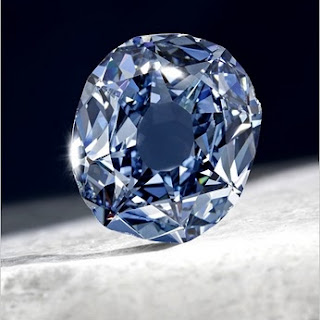The Wittelsbach-Graff Diamond is a 31.06 carats (6.21 g) fancy deep-blue diamond with internally flawless clarity. Laurence Graff purchased the Wittelsbach Diamond in 2008 for £16.4 million Sterling. In 2010, Graff revealed he had had the diamond cut by three diamond cutters to remove flaws. The diamond was now more than 4 carats (800 mg) lighter and was renamed the Wittelsbach-Graff Diamond. There is controversy, as critics claim the recutting has altered the diamond as to make it unrecognizable, that its historical integrity has been compromised.
Wittelsbach Diamond
The original Wittelsbach Diamond, also known as Der Blaue Wittelsbacher, was a 35.56-carat (7.11 g) Fancy Deep Grayish Blue diamond with VS2 clarity that had been part of both the Austrian and the Bavarian Crown jewels.
Its color and clarity had been compared to the Hope Diamond.[citation needed] The diamond had measured 24.40 millimetres (0.961 in) in diameter and 8.29 millimetres (0.326 in) in depth. It had 82 facets arranged in an atypical pattern. The star facets on the crown were vertically split and the pavilion had sixteen needle-like facets, arranged in pairs, pointing outward from the culet facet.
History
On display at the National Museum of Natural History in Washington, D.C.
The diamond originates from the mines of the former Indian kingdom of Golkonda. The story that King Philip IV of Spain purchased the jewel and included it in the dowry of his teenage daughter, Margaret Teresa, in 1664 is apocryphal. The first time the diamond was mentioned is about fifty years later when it was already in Vienna. It was in the possession of the Habsburg family and came to Munich when, in 1722, Maria Amalia married Charles of Bavaria, a member of the Wittelsbach family.
In 1745, the Wittelsbach Diamond was first mounted on the Bavarian Elector's Order of the Golden Fleece. When Maximilian IV Joseph von Wittelsbach became the first King of Bavaria in 1806, he commissioned a royal crown, which prominently displayed the diamond. Until 1918, the jewel remained on the top of the Bavarian crown. It was seen last in public at Ludwig III of Bavaria's funeral in 1921.
The Wittelsbach family tried to sell the diamond in 1931, during the Great Depression, but found no buyers. They eventually sold it in 1951.[citation needed] In 1958, the stone was shown at the World Expo in Brussels. In the 1960s, the Goldmuntz family asked Joseph Komkommer, a jeweler, to re-cut the diamond, but he recognized the historical significance of the stone and refused. Instead he, along with dealers, bought it. The diamond had been in a private collection since 1964. Later it became known that it was bought by Helmut Horten, who presented to his wife Heidi at their wedding.
On 10 December 2008, the 35.56-carat (7.11 g) Wittelsbach Diamond was sold to London-based jeweler Laurence Graff for £16.4 million Sterling, or US$23.4 million, at the time the highest price ever paid at auction for a diamond. The previous record had been held by a pear-shaped 100-carat (20 g) stone named the Star of the Season. This record was eclipsed on 16 November, 2010, when a 24.78 carat pink diamond was sold for £29 million Sterling, or US$46 million, again to Mr. Graff.
On 7 January 2010, it was reported that the diamond had been recut to enhance the stone's color and clarity, losing over 4.45 carats (890 mg) in the process. The resulting stone has been renamed the Wittlesbach-Graff. The move was met with heavy criticism by some experts: Gabriel Tolkowsky called it "the end of culture." Shortly after the auction of the diamond, American gem cutter and replicator of famous diamonds Scott Sucher stated "In the case of the Wittelsbach, what's at stake is at minimum over 350 years of history, as every nick, chip, and scratch has a story to tell. Just because we can’t decipher these stories doesn’t mean they don’t exist."[13] The alteration of the historical stone has been compared by Professor Hans Ottomeyer, Director of the Deutsches Historisches Museum of Berlin, to the overpainting of a painting by Rembrandt. It is opined that the recutting was done to increase its market value and, by extension, that of other "fancy diamonds". As a result of the recut, the gem had been reevaluated by the Gemological Institute of America and its color grade revised from Fancy Deep Grayish Blue, the same grade given by GIA to The Hope, to the more desirable Fancy Deep Blue. The diamond’s clarity had also been revised upward, from Very Slightly Included (VS1) to Internally flawless (IF).
http://en.wikipedia.org/wiki/Wittelsbach-Graff_Diamond







